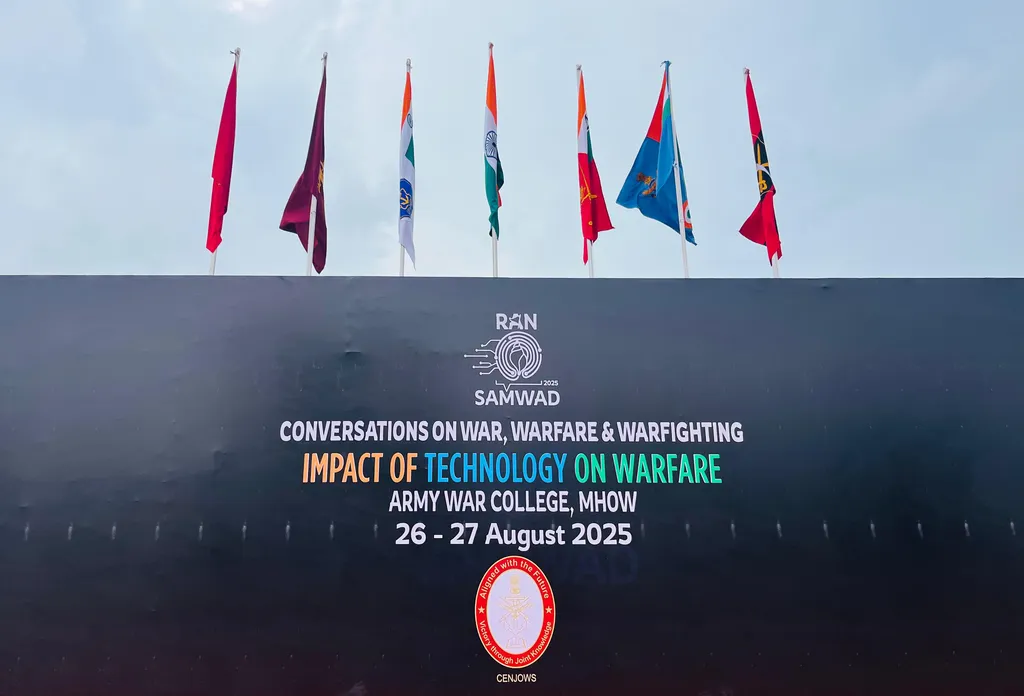The character of warfare is undergoing a seismic shift, driven by technological advancements that are redefining the very nature of conflict. The recent event, “RAN SAMVAD-2025,” held at the Army War College, brought this transformation into sharp focus. The discussions underscored that modern warfare is no longer about sheer manpower and firepower but about information dominance, precision, and speed. Emerging domains such as cyber, space, artificial intelligence, and autonomous systems are reshaping how battles are planned and executed.
Defence Minister Rajnath Singh highlighted this shift, praising Operation Sindoor as “a striking demonstration of technology-driven warfare.” His remarks echoed the broader sentiment that technology is no longer an auxiliary tool but the cornerstone of modern military strategy. The Chief of Defence Staff, General Anil Chauhan, reinforced this perspective in his keynote address, emphasising that “the ascendancy of technology requires swift and decisive joint responses across multi domains.”
The urgency of this technological transformation is palpable. The release of the Joint Doctrine for Multi-Domain Operations (MDO) at the event institutionalised the integration of land, sea, air, space, cyber, and cognitive domains. This doctrine reflects a global trend where militaries are reassessing how technology shapes strategy, operations, and leadership. The infusion of technology is not new, but today, the urgency is greater, the scope wider, and the consequences deeper.
Why the Hype Around MDO Now?
The urgency of adopting Multi-Domain Operations (MDO) today stems from the fact that technological and operational changes are no longer occurring in isolation but converging and unfolding simultaneously at a disruptive pace. Advances in AI, cyber, space, robotics, and information warfare are collapsing traditional boundaries between domains, creating fluid battlefields where superiority in one sphere is meaningless without integration across all. This convergence demands immediate adaptation, as delays risk leaving armed forces vulnerable to adversaries already leveraging these shifts.
The nature of modern warfare is being reshaped by several disruptive shifts, making Multi-Domain Operations (MDO) an urgent necessity. Unlike earlier revolutions driven by one or two key innovations, today we see the simultaneous maturing of technologies such as artificial intelligence, cyber, quantum computing, hypersonics, unmanned systems, space assets, biotechnology, and big data. Their convergence creates a powerful “system-of-systems” effect, with disruptive potential far greater than the sum of their parts.
At the same time, the boundaries between war and peace are increasingly blurred. Conflict is no longer limited to conventional battlefields; cyber intrusions, disinformation campaigns, and space denial operations now occur continuously below the threshold of open conflict, influencing societies, economies, and politics on a global scale.
The pace of technological change adds another layer of complexity. Digital systems evolve exponentially faster than traditional military platforms, and forces that fail to adapt risk rapid obsolescence. Moreover, the increasing interdependence of domains requires militaries to rethink doctrine and command structures. For instance, a cyberattack disabling radars can directly enable precision airstrikes, showing that actions in one domain can instantly shape outcomes in another. In this context, information has become the central determinant of victory. Where firepower and manoeuvre once dominated, information dominance now defines success. The side that can observe, orient, decide, and act faster—the OODA loop—gains a decisive edge.
Finally, warfare is shifting from a platform-centric to a network-centric paradigm. In the past, military advantage came from superior platforms; today it lies in the seamless integration of all assets into a cohesive, networked force. Legacy systems, no matter how advanced individually, can be rendered ineffective by a well-integrated multi-domain adversary. Together, these trends demand a fundamental transformation of military thinking, forcing armed forces to embrace MDO as the framework for future conflict.
Why the Technological Transformation to MDO is Proving to be Difficult
While the rationale for adopting Multi-Domain Operations (MDO) is compelling, militaries worldwide face significant challenges in translating the concept into reality. These obstacles are institutional, technological, human, and financial in nature. Legacy doctrines and institutional inertia often slow progress, as change disrupts established hierarchies and operational comfort zones. Integrating across domains is equally complex, since cyber and space effects are often invisible, difficult to quantify, and demand real-time joint data fusion—an immense technological and doctrinal challenge.
Technology gaps further complicate the transition. Many legacy platforms lack compatibility with digital systems and are difficult to upgrade, while access to cutting-edge technologies is restricted by geopolitical rivalries. This makes ‘Atma Nirbharta’—self-reliance in defence technology—a non-negotiable requirement. On the human front, traditional warfighters are trained in manoeuvre and firepower, yet MDO requires proficiency in artificial intelligence, cyber

